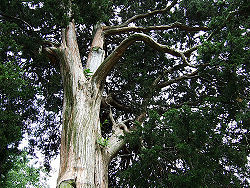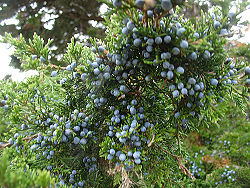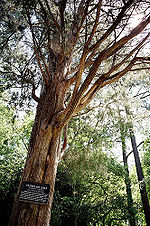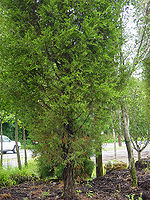Eastern redcedar
| Eastern redcedar |
|---|

|
| Scientific Classification |
|
| Binomial Name |
|
Juniperus virginiana |
| Image Description |
The Eastern Red Cedar is an evergreen conifer that grows all the eastern areas of the U.S., eastern Canada, and in Oregon. They are perhaps best know for their utilization as lining for clothes chests and closets due to its ability to repel moths.
Anatomy
The Eastern Red Cedar is usually from 5-20m, sometimes 27m tall, but may not grow any bigger than a bush in unhealthy soil. It has a relatively short trunk 30-100cm wide. The reddish brown bark is thick and peels off in narrow strips. They have two types of leaves, sharp, spreading needle like baby leaves about 510mm long, and tight, scale like adult leaves about 2-4mm long and they are put into opposite pairs or sometimes groups of three. The seed cones are about 3-7mm long with berries that have fleshy scales, dark purple and a white wax covering overall making it look light blue. They also have up to two seeds, and become mature in 6-8 months from when they are pollinated.[1]
Reproduction
The Eastern red cedar is a species that is dioecious. The tree will be mature enough to reproduce sexually, at an age of about ten years old. When the tree is able to reproduce sexually there will be conelets on the male trees that will develop on the tips of the auxiliary branches of the new leaves. In the month of September, pollen grains are formed in conelets that have ten to twelve margined sporophylls. Staminate strobili turn a dark yellow when they reach a mature state during the winter. The male trees are easily told apart from the female ones. During early fall or late summer small green conelets start to develop on the ovulate trees but grow very slowly during the winter. The conelets are born on the axillary branches of the new leaves but don't become noticeable until the late early spring. Mature eastern red cedar trees make seeds almost every year, but good crops are made only every two or three years. Mature fruits are usually stored as dried fruits or cleaned seeds and collected in the fall by hand-stripping or shaking onto a canvas.[2]
Ecology
This tree is commonly found in the prairies or oak barrens, old pastures, or limestone hills, mostly along highways and near recent construction sites. This is because it is a pioneer invader, which means that it's one of the first trees to grow in the eroded, or damaged land. In many areas the Eastern Red Cedar trees are considered a common and a native tree to the land. These trees often cause wild fires because they have low branches near the ground that burn and provide a ladder that lets fire light the whole tree on fire. Unlike the grasses, the Eastern Red Cedar are C3 plants which means that they rely on the natural CO2 concentrations in the air and more efficient at fixing CO2. The Eastern Red Cedar grow naturally in mainly all the eastern areas from Colorado, eastern Canada, and in Oregon.[3]
Uses
The Eastern Red Cedar wood is rot resistant and is therefore used for fence posts. The wood is soft, brittle, pink to brown, red heartwood, fragrant, very light and very durable. since the wood has a strong smell, the tree is avoided by moths. It is demanded as lining for clothes chests and closets, usually referred to as cedar closets and cedar chests. The wood, at one point, was a great wood for pencils. Also the wood can make great English style longbows, flatbows, and a Native American sinewed bow. The cones are used to flavor gin and can be used as a kidney medicine. They grow really well under bad conditions because they can grow in both droughts and in the cold. They grow in rocky, sandy, and clay substrate.[4]
Gallery
 Browse |
References
- http://en.wikipedia.org/wiki/Juniperus_virginiana#Description
- http://plants.usda.gov/java/profile?symbol=JUVIV
- http://www.na.fs.fed.us/spfo/pubs/silvics_manual/Volume_1/juniperus/virginiana.htm







